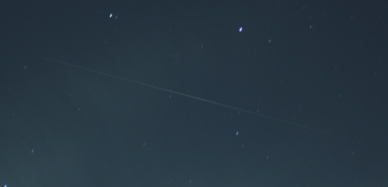It's
a Bird, It's a Plane, It's....
an
indication you are at least as old as I am, if you know what comes
next. However, in this case, it's a couple of images of one of the
things I usually try to avoid imaging: a satellite. Specifically, an
Iridium satellite. Even more specifically, and Iridium flare. What
that is, is when the solar panels align with the sun, the satellite,
and the person to cause and intense, short term brightening.
 |
| Iridium flare |
This
image is a 15 second exposure and shows most of the flare. You can
see it starts fairly dim at the left side of the image, and over a
few seconds, becomes very bright, and then start to dim again.
Unfortunately, the exposure ended before the satellite returned to
its original brightness. By the way, the star basically above where
the trail of the satellite ends (and the brightest star on the right
side of the image), is Regulus in the constellation of Leo, the Lion.
Of course, this is a time lapse image, but visually, you see the
satellite moving, in this case from left to right, and suddenly
growing bright enough to the be brightest moving object in the sky,
and then dim again, all in about 30 seconds. It's really kinda cool.
It
should be noted that this is only a small portion of the entire
image. The full image is below.
 |
| The big picture |
This
is a fairly large portion of the sky. The flare looks much small,
huh? Almost directly below the flare, but just out of the frame is what appears
to be a bright light. Actually, it is. It's the moon.
 |
| Flare occurred about as far above the moon as the moon is above the trees. |
This
image shows the scale of the previous image, meaning in this case,
just how much of the sky the camera saw. At least, you get some idea.
 |
| Just the moon from the image above. |
This
shows just how well a DSLR with a stock zoom lens, set to wide field,
can capture the moon. Basically, this is what a “normal” DSLR
would see. So, if you have one, and would like to know how well you
might be able to take a picture of the moon, this is it. The image
has been resized to 2x in “post processing”, meaning the imaged
adjusting software I use, which is a very old version of Paint Shop
Pro. The Mare are clearly visible. The camera was mounted on a tripod
and a remote shutter release used to help minimize any camera
shaking.
I
was a little disappointed that I didn't capture the entire flare, so
the next night, April 8th, I went out to get another
flare. However, there were a fair number of clouds. Even though this
was a much dimmer flare, I think it still looked pretty with the
clouds and moon just out of frame.
 |
| Iridium flare just below center of the picture, behind some clouds. |
And
here is just the flare part where you can see the satellite going
from dim to bright back to dim.
 |
| Dimmer flare, but shows the entire flare |
Finally,
on the night of the first flare images, April 7th, I took
a few “through the telescope” images of the moon. One of the
things I have been trying to do is get at least one image of each of
the objects on the Astronomical League's Lunar List. Even though I
already had an image of the crater Billy, I thought this was a better
one.
 |
| Crater Billy |
Obviously,
this is the crater. But notice the crater floor; it's a dark gray and
appears smooth. What's
different? From my reading, the crater is considered an impact crater
meaning, of course, something hit the moon and left a crater. But
then the crater was flooded with lava, leaving the smooth and dark
appearance. Looking at other craters, you will almost always see a
central peak. That peak is the result of the impact. That Billy has
no central peak implies that the lava flowed into it after the
impact.
No comments:
Post a Comment